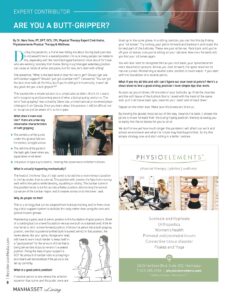ARE YOU A BUTT-GRIPPER?
During the pandemic, a  friend was telling me about having back pain due to increased time in a seated position. I’m sure many people can relate to this, especially with the restricted opportunities to move about for those who are working remotely from home. Being in a prolonged sedentary position can cause all kinds of aches and pains, but for now, let’s start with sitting!
friend was telling me about having back pain due to increased time in a seated position. I’m sure many people can relate to this, especially with the restricted opportunities to move about for those who are working remotely from home. Being in a prolonged sedentary position can cause all kinds of aches and pains, but for now, let’s start with sitting!
She asked me, “What is the best kind of chair for me to get? Should I get one with lumbar support? Should I just get a lumbar roll?” I answered, “You can get the best chair with all the frills, but if you’re sitting in it incorrectly, it won’t do any good. Are you a butt-gripper??”
What does it even look like? There are a few key observable characteristics of butt-gripping:
- The wrinkles of the pants under the gluteal fold are horizontal, straight across
- The belt-line of the pants in the back gets lower when you squat down or sit down
- The pelvis is typically tucked in, creating the appearance of flatter buttocks.

What is actually happening mechanically?
The head of the femur (top of thigh bone) is forced into a more forward position in the hip socket than is optimal. This position will prevent the hips from moving well within the pelvis while bending, squatting or sitting. The lumbar spine in this position tends to be forced into a flatter position, diminishing the normal curvature of the lumbar region and increases stress on to the lower back.
Why do people do this?
This is a strategy that can be adopted from habitual training and/or from creating a false support system to stabilize the body rather than using the core and gluteal muscle groups.
Maintaining a good, neutral pelvic position is the foundation of good posture. (think of a building built on a level foundation versus one built on a slanted one). If the femur tends to sit in a more forward position, it forces the pelvis into a butt-gripping position, one that is posteriorly-tilted (a/k/a tucked pelvis). In that position, the levels above, like your spine, ribcage and head, will have to work much harder to keep itself in a “good posture” for the amount of time that is
being demanded of you to remain in a seated position. Fixing the base of your support is KEY! No amount of lumbar rolls or pricey highend chairs will be beneficial if the pelvis is not set up correctly.
What is a good pelvis position?
A neutral pelvis is one where the anterior superior iliac spine and the pubic bone are lined up in the same plane. In a sitting position, you can find this by finding your “sit bones.” Try rocking your pelvis forward and backward and locate the boniest part of the buttocks. These are your sit bones. Rock back until you’re off your sit bones; now you’re sitting on your tailbone. Now rock forward until you find your sit bones again.
You will also start to recognize that as you rock back, your spine becomes more slouched in posture. And as you rock forward, the spine resumes its natural curves. Maintaining a neutral spine position is much easier if you start with the foundation of a neutral pelvis.

What if you try all this and still can’t figure out your neutral pelvis? Here’s a cheat sheet to find a good sitting position! I love simple tips that work.
As soon as you sit down, lift one side of your buttocks up. Grab the muscles and the soft tissue of the buttock that is raised with the hand of the same side, pull that tissue back (yes, towards your back) and sit back down.
Repeat on the other side. Make sure the knees are lined up.
By moving the gluteal muscles out of the way, towards the back, it allows the pelvis to move forward from the butt-gripping position, thereby allowing you
to easily find the sit bones for you to sit on.
We don’t know yet how much longer this pandemic will affect our work and school environment and what the future may hold beyond that. So try this simple strategy now and start sitting in a better posture.
Dr. Nara
